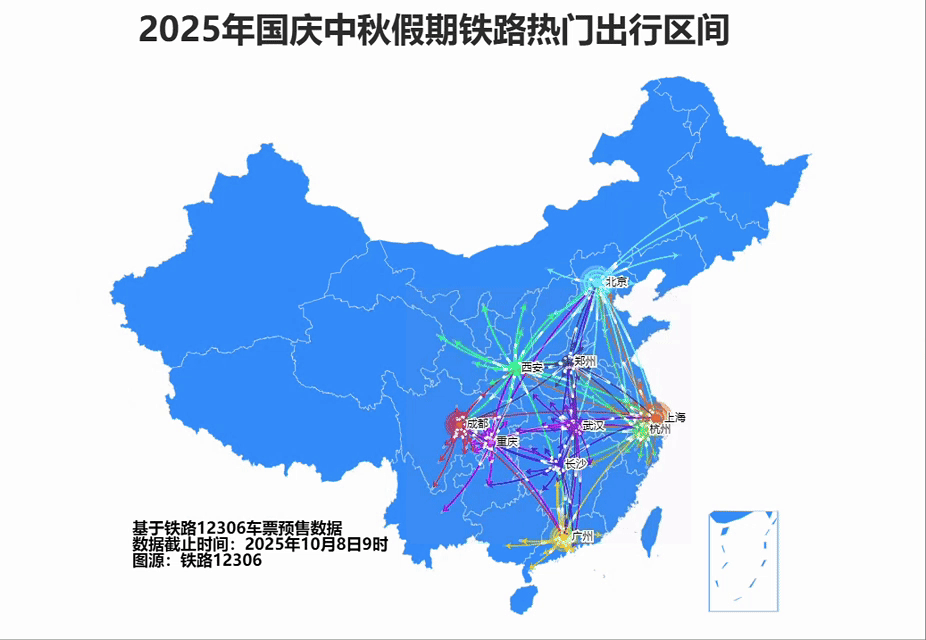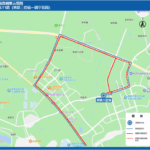From October 1st to 8th (Mid-Autumn Festival and National Day holiday), the total cross-regional passenger movement volume reached approximately 2.432 billion trips, with a daily average of 304 million trips, representing a year-on-year increase of 6.2%.
By transportation mode: total railway passenger volume reached approximately 153 million trips, with a daily average of 19.24 million trips, up 2.6% year-on-year; total waterway passenger volume reached approximately 11.67 million trips, with a daily average of 1.46 million trips, up 4.2% year-on-year; total civil aviation passenger volume reached approximately 19.17 million trips, with a daily average of 2.4 million trips, up 3.4% year-on-year.
Total road passenger movement volume (including non-commercial small passenger vehicle travel on highways and ordinary national/provincial roads, plus commercial road passenger transport) reached approximately 2.247 billion trips, with a daily average exceeding 280 million trips, representing a year-on-year increase of 6.5%.
“Overall, public travel demand during this year’s National Day holiday was strong, mainly showing four characteristics.”
In terms of travel scale, tourism and family visit flows overlapped at high levels during this year’s holiday, with cross-regional passenger movement volume exceeding 2.4 billion trips and a daily average exceeding 300 million trips, reaching a record high. In terms of travel modes, passenger volumes for railways, roads, waterways, and aviation all achieved year-on-year growth, with continuous improvement in transportation service capacity across all modes.
In terms of travel distribution, the first day of the holiday saw the peak travel period, with cross-regional passenger movement volume reaching 336 million trips, setting a new record for the same period. In terms of travel destinations, urban clusters such as Beijing-Tianjin-Hebei, Yangtze River Delta, Guangdong-Hong Kong-Macao Greater Bay Area, Chengdu-Chongqing, as well as metropolitan areas including Xi’an, Changsha, and Wuhan, experienced concentrated passenger flows.
Mid-Autumn Festival
The Mid-Autumn Festival is a major harvest celebration with roots in China’s ancient moon worship traditions during the Shang Dynasty. It is traditionally held on the 15th day of the 8th lunar month to give thanks for the harvest and symbolizes family reunion. The festival is widely celebrated today with activities such as eating mooncakes and gazing at the full moon.
National Day
“National Day” is not a specific place or cultural site, but a holiday celebrating a nation’s independence, founding, or a significant historical event. For example, France’s National Day on July 14th commemorates the storming of the Bastille in 1789, a key event of the French Revolution. These annual celebrations often involve military parades, fireworks, and public festivities to foster national unity and pride.
Beijing-Tianjin-Hebei
The Beijing-Tianjin-Hebei region is a major economic and cultural hub in northern China, historically known as Zhili or Jing-Jin-Ji. It centers on Beijing, the ancient capital with imperial history, the port city of Tianjin, and Hebei Province, which historically protected the capital. Recently, it has been developed into a coordinated, integrated region to drive economic growth.
Yangtze River Delta
The Yangtze River Delta is a fertile and economically vital region in eastern China, centered on Shanghai. Historically, its intricate network of rivers and canals facilitated trade and agriculture, making it a cultural and commercial hub for centuries. Today, it is one of the world’s most important economic zones and a major driver of China’s modern growth.
Guangdong-Hong Kong-Macao Greater Bay Area
The Guangdong-Hong Kong-Macao Greater Bay Area is a major economic and business hub in southern China, encompassing nine cities in Guangdong Province along with the special administrative regions of Hong Kong and Macao. It was formally promoted as a national development strategy in 2017, building upon the region’s historical economic ties and the “one country, two systems” principle. The initiative aims to deepen integration and create a world-class city cluster for innovation, commerce, and cultural exchange.
Chengdu-Chongqing
The Chengdu-Chongqing area is a major economic hub in southwestern China, historically connected by the challenging travel routes of the Sichuan Basin. Its modern development was significantly accelerated by the construction of the Chengdu–Chungking Railway in the 1950s, which linked the two cities. Today, it is a powerhouse of industry and commerce, forming one of China’s most important inland urban clusters.
Xi’an
Xi’an is one of China’s oldest cities, serving as the capital for multiple dynasties including the Zhou, Qin, Han, and Tang. It is most famous as the eastern terminus of the Silk Road and for the Terracotta Army, discovered in 1974, which guards the tomb of China’s First Emperor, Qin Shi Huang. Today, Xi’an remains a major cultural and historical hub, blending ancient city walls and pagodas with modern urban development.
Wuhan
Wuhan is a major city in central China, formed in 1927 from the merger of three historic towns: Wuchang, Hankou, and Hanyang. It is historically significant as the site of the 1911 Wuchang Uprising, which led to the fall of the Qing Dynasty and the establishment of the Republic of China. Today, it is a key economic and transportation hub, known for its universities, research institutions, and its location on the Yangtze River.



